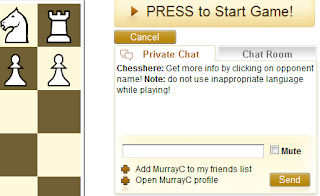Ok, you logged in to a chess on-line web site and you are ready to start a game but how could you find an opponent? There are several ways to. The most common is the direct challenge: from the list of on-line users you chose the one you would like to play with. Yes, maybe you know the player by its nickname and would like to play with him/her, or looking at the player rating you can chose to challenge someone a bit stronger than you to increase your own rating. So the choice is yours in this case.
Figure 7 – http://www.chesshere.com allows the player to invite another player and to show the list of current invitations
Figure 8 – http://www.chesscube.com game creation with rating range constraint
What happens if there is none who can play with you? Play against a computer seems to be a forced choice but is it what you really wanted? It is better to be clear: “Sorry, no one available. Retry or if you want you can play against the machine”.
Interesting is the feature to invite a friend of yours even if he/she is not a registered user. The invitation needs only the email address and if your friend is checking his/her email in that moment he/she could join the game with you (but if he is not connected…).
I talked about friends. That is a concept widely used in most gaming web sites. You have the chance to maintain a list of other users (your friends) and check if they are connected, if so you can challenge one of them or chat with him/her. The concept behind is simple: a friend is someone you want to be connected with, someone you want to play with often. Some online chess providers have another interesting feature which is the opposite of friends: a list of people you don’t want to play with. In fact when the system finds automatically an opponent for you, you won’t have the chance to reject the match usually (in some case instead that is possible: the game can be null if the player doesn’t move his first move or acknowledges the match). Using the black list (or block list or no-play list) the system will not create a match between you and the undesired user.








